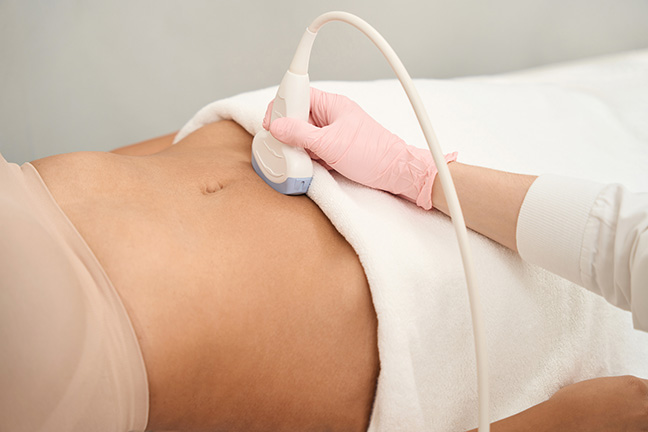Physiotherapy is the healthiest way to treat musculoskeletal pain. Our approach addresses the root causes of your discomfort without medications or surgical interventions. We naturally treat back, head, and joint pain. Through movement and other physiotherapy methods, we also positively influence the functions of other systems, including mental health.
This involves a set of examination methods leading to a diagnosis and the creation of a therapeutic plan. The examiner must understand anatomy, biomechanics, and kinesiology, as well as the structure and behavior of various tissues. Information is gathered through observation, palpation, and other clinical examination components. The evaluator must determine whether the issue originates from the musculoskeletal system.
The examination results form the basis for the rehabilitation plan. For most conditions, active client participation is essential. Clients should not place full responsibility on the therapist but recognize that their own effort is key to a positive outcome. The therapist's role is to motivate the client appropriately.
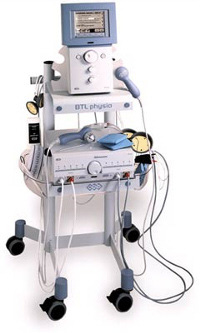
Electrotherapy is a popular treatment that uses various types of electrical currents to improve tissue blood flow, relieve muscle tension, or strengthen muscles. It combats pain and inflammation. The type of electrotherapy is chosen based on the predominant condition. It can treat musculoskeletal diseases, circulation disorders, inflammatory and degenerative conditions, postoperative states, skin problems, and more.
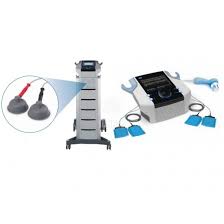

Types of Electrotherapy:
TENS (Transcutaneous Electrical Nerve Stimulation):
Used to treat various painful conditions such as spinal, joint, and tendon pain, headaches, post-injury musculoskeletal pain, phantom limb pain, and more.
Diadynamic Currents:
Primarily have analgesic effects. This method applies low-frequency direct electrical current. Main indications include post-injury states (bruises, muscle strains, joint sprains), musculoskeletal diseases (back pain, cervicocranial and cervicobrachial syndrome, osteoarthritis), neuralgia, neuritis, circulation disorders (Raynaud's disease, varicose veins, vein inflammation, frostbite, lower limb ischemic disease).
Interferential Currents:
Treatment is based on the interference of two medium-frequency currents directly in the tissue. Interferential currents are used more for chronic conditions, whereas diadynamic currents are for acute states. Indications include chronic inflammatory and degenerative musculoskeletal diseases, muscle, tendon, and bursa diseases, fractures, bone diseases, bruises, joint sprains, osteoarthritis, spondylosis, ankylosing spondylitis, back pain, neuralgia, neuritis, vascular diseases, gynecological inflammations, abdominal adhesions, asthma, and many others.
Träbert Currents:
Low-frequency pulsed currents with significant analgesic effects, used similarly to the above methods, especially after injuries, for back pain, suitable for degenerative diseases of small and large joints, chronic inflammatory rheumatic diseases affecting joints, to alleviate nerve and muscle pain.
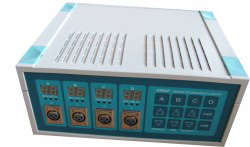
Magnetotherapy utilizes pulsed magnetic fields to increase blood flow, reduce inflammation, alleviate pain and swelling, relax muscle spasms, and accelerate the healing of bones and soft tissues.
Indications: Post-fracture recovery, degenerative and inflammatory musculoskeletal diseases, functional disorders.

The laser has biostimulatory, analgesic (pain-relieving), and anti-inflammatory effects. The method is completely painless, safe, and cannot damage any tissue.
This is one of the most advanced methods of physical therapy for treating painful conditions of the musculoskeletal system. The laser beam is capable of penetrating up to 12 cm deep, thereby affecting tissue structures located deep beneath the skin. In the case of the robotic scanner, it is the first intelligent robotic system capable of covering body areas up to 1200 cm². Clinically effective and safe treatment parameters are individually tailored to each patient.
The laser beam can provide immediate, significant, and long-lasting pain relief. Noticeable improvement is often seen on the very first day of treatment. The laser has the ability to gently influence the cellular environment, target inflammatory processes, relax and regenerate muscles, and reduce pain.
We use the laser for joint and tissue regeneration as well as for supporting healing in post-traumatic conditions — this includes reducing inflammation, improving blood flow, decreasing swelling, and supporting the healing of post-surgical scars. Laser therapy should always be part of a comprehensive treatment plan.
Most Common Indications for High-Power Laser Therapy:
● Pain in the musculoskeletal system
● Muscle spasms and treatment of trigger points
● Tendon attachment pain (e.g. tennis and golfer’s elbow, knee pain, Achilles tendon, heel spurs, etc.)
● Shoulder joint pain
● Carpal tunnel syndrome
● Tinnitus (ringing in the ears)
● Osteoarthritis of large joints – both acute and chronic pain
● Post-traumatic conditions
● Arthritis and rheumatism
● Facial nerve palsy
● Scar therapy
Contraindications for Therapeutic Laser Treatment:
● Pregnancy (abdomen and lower back area)
● Pacemaker
● History of cancer
(does not apply to distant body parts after confirmed cancer remission)
● Thyroid disorders
● Seizure disorders (e.g. epilepsy, febrile seizures)
● Bleeding conditions, including during menstruation
(avoid application on the abdomen and lower back)

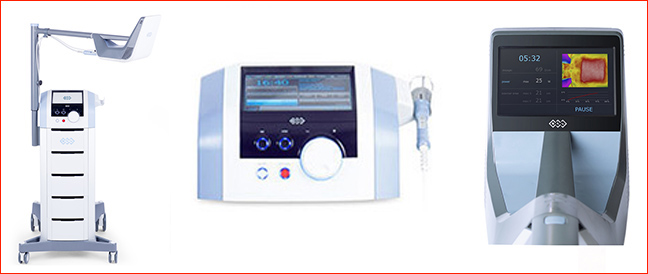
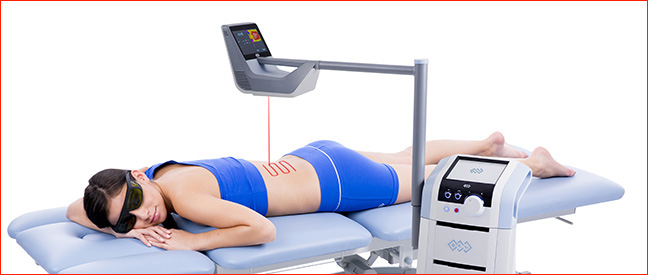
Ultrasound examination (sonography) is a traditional imaging method that is safe, painless, and gentle on the body, requiring no prior preparation, and having no side effects or absolute contraindications.We use sonography to evaluate the condition of soft tissues, joints, and peripheral nerves. Both static and dynamic examinations are performed on clinically important areas.This examination is essential for assessing pathological changes in the affected segment. Based on the findings and the timeline of the issue, we can propose appropriate and precisely targeted treatment or recommend lifestyle and activity adjustments.



Ultrasound is a mechanical wave with a frequency higher than 20,000 Hz.
During its therapeutic application, no electrical current passes through the tissues, which means it is classified as a form of mechanotherapy.
Ultrasound improves blood circulation in tissues, promotes the absorption of swelling and effusions, reduces pain, enhances metabolism, relieves muscle tension, and supports scar healing and the treatment of heel spurs.
Mobilization (MOB) and soft tissue techniques (MT) are methods used in manual therapy. These techniques—especially for the spine and peripheral joints—are among the most important and commonly used approaches for treating painful myofascial trigger points.
Soft tissue techniques (MT) specifically target the skin, subcutaneous tissue, fascia, muscles, and their attachments. They help release muscle spasms and eliminate so-called reflexive pain-related changes in muscles and surrounding structures. Treatment proceeds from the superficial layers to the deeper ones.
Mobilizations (MOB) are a form of manual therapy in which joint play and functional mobility are gently and gradually restored in a blocked joint.
Joint blockages often occur in areas that are overloaded due to one-sided or asymmetrical strain, not only from dynamic activities but especially from static postures—for example, prolonged incorrect sitting, or poor posture while standing, walking, or performing other daily tasks.
• Manual
Lymphatic massage is a very gentle massage technique performed using slow and soft strokes on the skin. Following precisely defined techniques, lymph is guided toward collecting lymph nodes, from where it is transported—along with toxic substances—into the central lymphatic system. It then enters the bloodstream and is eliminated from the body via the kidneys and urine.
• Mechanical (Device-Assisted)
Mechanical lymphatic drainage is based on intermittent compression of the limb, creating a pressure wave that supports both the lymphatic and venous systems.
Effects: Detoxification (removal of toxins from the body), Metabolism support, Prevention of swelling and varicose veins, Drainage of swelling after injuries, Relief from tired or heavy legs, Reduction and prevention of cellulite, Slowing down the aging process
Mechanical lymphatic drainage works by applying rhythmic pressure, encouraging lymphatic and venous circulation.
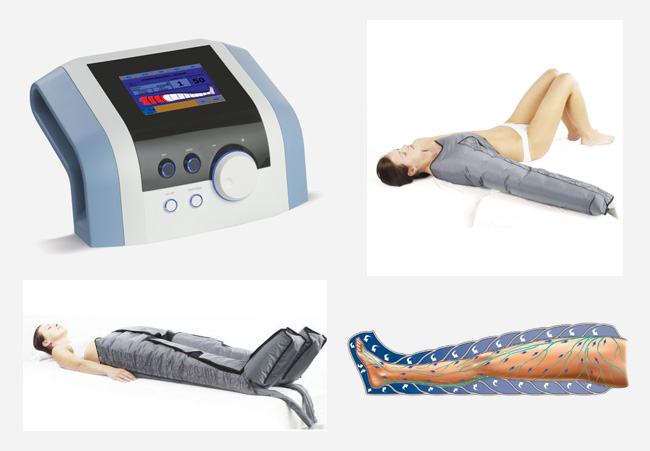
A podoscope is a diagnostic device used to assess orthopedic conditions of the feet. It allows for a detailed evaluation of the weight-bearing areas of the foot. This examination helps to detect abnormalities in the small joints of the foot, as well as in the positioning, pressure, and rotation of the heel bones and the relative alignment of various foot segments.
It assists in evaluating the longitudinal and transverse arches of the feet and identifying their disorders, most commonly seen in flat feet. The podoscope consists of a glass platform with an angled mirror underneath.
The patient stands on the glass plate, and the mirror displays the distribution of pressure across different parts of the feet and helps identify other potential causes of problems. The device allows us to observe the static posture of the feet, detect disproportions or asymmetries between the left and right foot, and compare the condition of the feet with the alignment of the entire musculoskeletal system, including the pelvic bones and shoulders.
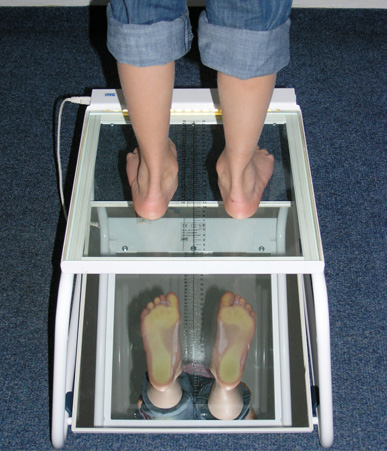
Reflex massage, unlike classic massage, acts primarily on the nervous level. With the involvement of higher nerve centers, various reflex processes occur. Changes in internal organs can thus cause changes on the surface of the body, in muscles, or other internal organs, and vice versa. During reflex massage, the physiotherapist aims to eliminate all reflexively caused changes in tissues that can be treated from the body surface and thereby affect the reflex arc causing the pathology. This therapeutic method is used primarily in functional, degenerative, and chronic rheumatic diseases of the spine and joints, post-injury conditions, circulatory disorders, and functional diseases of internal organs. Reflex massage is performed dry, without the use of massage agents, and the strokes are performed slowly.
Therapeutic physical education based on neurophysiological principles (LTV on NFP) includes methods and concepts that utilize neurophysiological principles. These are types of exercises that stimulate the central nervous system for adaptive processes. It is based primarily on psychomotor development. The exercises involve activation of individual muscles within muscle groups.
Methods and concepts used:
● Application of the Roswitha Brunkow method
● DNS (Dynamic Neuromuscular Stabilization)
● ACT (Acral Coactivation Therapy)
● Sensorimotor training
Therapeutic physical education (LTV) serves to practice correct movement patterns, strengthen and stretch muscle groups, eliminate problems caused by one-sided overload, thus improving the overall condition of the organism, restoring correct posture, and preventing injuries. Exercises focus on practicing controlled breathing (breathing gymnastics).
Ludmila Mojžíšová (1932–1992) was an important Czech physiotherapist whose name is still associated with effective treatment of functional disorders of the musculoskeletal system and functional female infertility. Her experience working with athletes led her to develop her own method combining mobilization techniques and targeted exercises. Gradually, she discovered that her approach also produced significant results in women suffering from infertility. Under the name "Rehabilitation treatment of certain types of female infertility by the L. Mojžíšová method," this method was officially recognized in 1990 by the Czech Ministry of Health as a recommended procedure for treating functional female infertility. Its clinical effectiveness was verified in collaboration with gynecologist Prof. Evžen Čech.
This method involves reflex influence on the neuromuscular apparatus of the pelvic floor, i.e., by removing muscle imbalance in the pelvic area, its better blood circulation with additional positive effects is achieved. However, it does not treat the pelvis as a separate unit. Patients must be treated as a whole. Therefore, the method also focuses, among other things, on blockages of ribs, spine, pelvis, and coccyx, working with scars, etc. This relates to so-called vertebrovisceral relationships (spinal pain affects corresponding internal organs) and conversely viscerovertebral relationships (internal organ disorders propagate into the musculoskeletal system).
The method is not only intended for women suffering from functional infertility but is also applicable to men (blockage of the 7th rib influences spermogram values in men).
As in all approaches, emphasis is placed on patient individuality and new findings from medicine and physiotherapy. Modern sonographic devices are used to examine pelvic floor muscles during treatment.
Therapy usually lasts 6 months, includes several visits, and successful results require daily, regular exercises.
Most common indications for the Ludmila Mojžíšová method:
• functional infertility in women
• menstrual cycle disorders without organic cause (e.g., irregular cycle, prolonged menstruation, painful menstruation)
• conditions after childbirth or gynecological operations (e.g., cesarean section)
• pain during sexual intercourse
• incontinence
• painful coccyx (after falls on the coccyx, X-ray examination is necessary to exclude coccyx fracture)
• male infertility without organic cause (positive effect on spermogram)
• back pain, neck spine, head pain, joint blockages
• psychosomatic difficulties associated with tension in the pelvic area
• helps women during menopause
Contraindications:
• acute inflammatory and painful conditions
• unhealed coccyx fractures
• malignant conditions
The L. Mojžíšová method offers a natural and effective approach to solving problems of the musculoskeletal and reproductive systems.
If you are interested in therapy by the Ludmila Mojžíšová method, have questions, or are unsure if this method would be suitable for you, do not hesitate to ask our doctors or physiotherapists.

